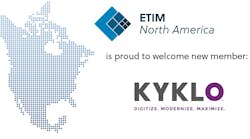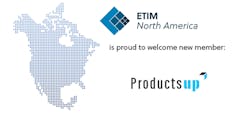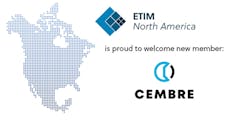Every once in a great while, a new technology takes an industry by storm. Its advantages and cost of entry are so appealing that it quickly transforms a business. Think of the check-in kiosks at airlines, fax machines and ATMs. These technologies seemed to fly from just-off-the-radar screen to “I can't-live-without-you” status within nanoseconds.
That's not the case with radio frequency identification (RFID) technology. Your company can live without RFID tags — for at least a few more years. But the electrical wholesaling industry is slowly and painfully evolving into a world where the movement of products from point of manufacture to point of purchase will be tracked in real time. Product data will be analyzed by date of manufacture, the amount of time it sits on warehouse shelves, and variables we can't even yet imagine.
RFID technology can do that job. An RFID system has a tag equipped with a microchip that contains information about a product, person, pet, or infinite number of other entities one might want to track; an antenna on that tag to transmit the data; and a reader to pick up the data and relay it to a computer or other device that decides what to do with the data.
If you have read this far in this article, then you are probably already imagining how RFID tags might help track incoming shipments into your warehouse, cut down on the painfully manual process of cycle counting inventory, and help create customers' purchasing history by some very important marketing variables, such as type of company, time of day/month, average order quantity and many other handy bits of information.
Alas, as with many good things, cost is an issue. According to several research studies on RFID technology, prices for RFID tags are still too high to convince many potential users that the technology is cost-effective. Industry analysts don't expect RFID technology to really get popular in an industry like wholesale-distribution until the price drops to a nickel each for the simple “passive” tags that just emit a signal when they pass through a RFID reader. The ‘brainier’ active tags, which supply their own power with an onboard battery, are more expensive. Prices for both types of RFID tags vary depending on the sophistication of the tags, but several studies said current prices for RFID tags average from 25 cents to 35 cents. At these prices, RFID tags are still pretty expensive if you must tag hundreds, thousands or millions of products.
Still, distributors and manufacturers are already thinking about how to apply RFID technology. Mike Rioux, president, Industry Data Exchange Association (IDEA), Rosslyn Va., says IDEA already has a subcommittee studying RFID applications in the electrical business. He also said Rockwell Automation, Milwaukee, Wis., and several other large manufacturers are exploring RFID's potential.
According to Rioux, the advantage of RFID technology over bar-code technology is that it can handle more data attributes and has an easier scan/read capability. He believes these advantages will lower stocking costs and boost productivity. However, Rioux believes the cost of RFID tags, readers and support systems will hold back growth in the near term.
“It will take three to five years before a mass shift takes place in adopting RFID,” he says. “In my opinion, those involved in RFID are more enamored with the technology than they are with cleaning up data that gets stored on the chip. Bad data delivered in a RFID tag is still bad data — it's just more expensive to get into your back-end system.”
Allen Ray, president, Allen Ray Associates Ltd., Arlington, Texas, says there are security issues with RFID relating to the interception of data. He also says questions exist with RFID relating to the Universal Standard Products and Services Classification (UNSPC), a coding system used to classify products and services for the global marketplace.
Waiting for Wal-Mart
Much of the momentum powering the implementation of RFID technology can be traced to directives by Wal-Mart and the Department of Defense (DOD) that require their suppliers to tag products with RFID devices. Wal-Mart had its 100 largest suppliers on a tough Jan. 1 deadline to have certain products tagged. The ultimatum sent shock waves throughout the retail world. The Defense Department also had a January “tagging” deadline for its suppliers.
It's tough to say when or if the electrical industry will have its own “Wal-Mart moment” that drives companies en masse toward RFID. But if it does happen, expect the companies that must tag their products to do so with gritted teeth and a wary eye on the payoff of what will be a sizeable investment.
25 Really Cool Ways RFID Tags are Already in Play
Although it will be several years before RFID tags are as common as locknuts in the electrical business, you don't have to look too far to find them in many other consumer, retail, medical and security applications. Here are the most common uses of RFID technology:
-
Nearest and dearest to the hearts of wholesalers are applications in the warehouse. Cartons, pallets or shipping totes now have RFID tags to cut down on manual scanning for bar codes, inventory-cycle counts and other labor-intensive warehouse tasks.
-
Manufacturers track the assembly processes along manufacturing lines of dozens if not hundreds of different products.
-
Hands-free “smart card” technology in banking applications allows users to speed up banking transactions.
-
Since 1997, Exxon Mobil has offered its RFID-enabled SpeedPass to help drivers gas up quickly. Customers are also using SpeedPass at convenience stores and at McDonald's restaurants.
-
RFID tags the size of a pencil lead are loaded with identification and inserted into pets and other animals to track their movements, and, in the case of lost pets, to return them to their owners. And, yes, some humans have been “tagged” for similar reasons.
-
Anti-theft hard tags containing RFID transponders are attached to clothing to help store managers prevent merchandise theft.
-
RFID tags mounted to shipping containers, railroad cars, trucks and heavy machinery track their movement.
-
Skiers in Europe purchase credit-card sized ski passes embedded with RFID tags so they don't have to hassle with conventional tags.
-
Since 1999, marathon runners have fastened RFID chips to the laces of their running shoes. RFID readers at the starting line, mile markers and finish line track the progress of runners along a course. In some races, these timing splits are accessible via the Web for family and friends not at the races.
-
Express parcel services use RFID tags to track packages throughout all stages of the delivery process.
-
Legal firms and insurance companies now use RFID tags to manage and locate cases, claims and other important documents.
-
Farmers and ranchers use RFID technology to manage livestock herds.
-
Naturalists tag wild animals and even fish to track migration patterns.
-
RFID tags sewn into clothing help retailers track product movement.
-
Retailers also use RFID technology to protect themselves from counterfeit merchandise.
-
Drivers along the I-95 corridor on the East Coast use the EZ pass toll collection system so they don't have to scrounge around for change or bills before passing through tollbooths. RFID readers at the tollbooths read transponders attached to vehicles, and drivers receive a monthly bill for their tolls.
-
FedEx drivers use a keyless lock system enabled by RFID technology to open their vehicles. Drivers wear a RFID bracelet and wave it past readers on a truck's doors to open them.
-
Airlines are slowly but surely replacing bar code technology with RFID tags in baggage-handling applications.
-
Access badges are a hands-free solution that allow employees into buildings or certain rooms within a building.
-
Access badges are now also common with security-minded employers in the airline, maritime and railroad industries where access to many areas in airline terminals, train stations and ports is strictly monitored.
-
Car dealers manage inventory of new and used vehicles at their dealerships by tagging vehicles.
-
ID bracelets enabled by RFID chips allow hospital staff to track a patient's location and quickly access patient information.
-
Entertainment cards for nightclubs and other entertainment venues are being used as a cash-free alternative for purchasing drinks, food and other services.
-
Trucking companies track their fleets with RFID tags.
-
Employers control access to parking lots with RFID tags.
RFID Resources
DC Velocity magazine has been covering RFID technology for years because of its editorial focus on logistics and warehousing technology at distribution centers. The magazine's Web site at www.dcvelocity.com is a great resource.
The Association for Automatic Identification and Mobility (AIM) is a trade association for providers of components, networks, systems and services that manage the collection and integration of data with information management systems. www.aimglobal.org
www.rfida.com is an eclectic online resource offering lots of interesting information on the state of RFID technology.
The International RFID Business Association (RFIDba), McClean, Va., helps end users with the implementation of RFID technologies in their businesses. www.rfidbusiness.org
Texas Instruments, Dallas, is a major provider of RFID equipment and offers a ton of white papers and RFID 101 information on its Web site at www.ti.com/rfid/.
Intermec, Everett, Wash., is another big player in the RFID game that offers lots of good information on its Web site. Check out www.intermec.com.
The Industry Data Exchange Association (IDEA), Rosslyn Va., already has a subcommittee laying the groundwork for RFID usage in the electrical business. For more information, call Mike Rioux, IDEA president at (703) 841-3250 or by e-mail at [email protected].








